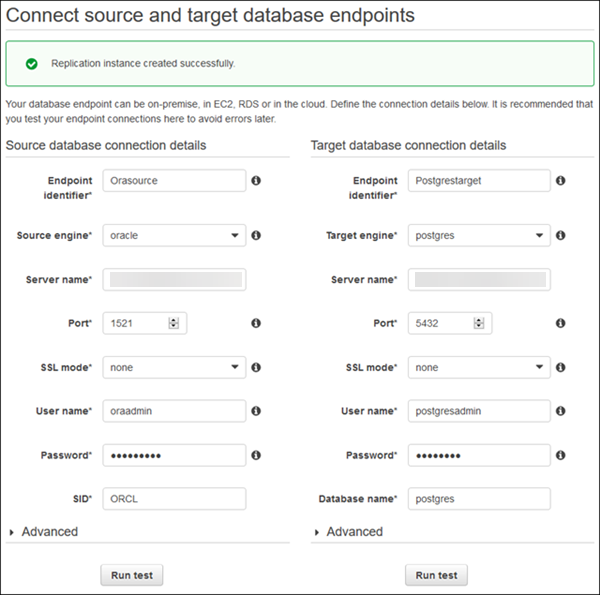Step 6: Create Amazon DMS Source and Target Endpoints
While your replication instance is being created, you can specify the source and target database endpoints using the Amazon Web Services Management Console
-
Sign in to the Amazon Web Services Management Console, open the Amazon DMS console
, and then choose Endpoints. -
Specify your connection information for the source Oracle database and the target PostgreSQL database. The following table describes the source settings.
Parameter Description Endpoint Identifier
Enter a name, such as
Orasource.Source Engine
Choose oracle.
Server name
Provide the Oracle DB instance server name.
Port
The port of the database. The default for Oracle is
1521.SSL mode
Choose an SSL mode if you want to enable encryption for your connection’s traffic.
Username
The user you want to use to connect to the source database.
Password
Provide the password for the user.
SID
Provide the Oracle database name.
The following table describes the advanced source settings.
Parameter Description Extra connection attributes
Extra parameters that you can set in an endpoint to add functionality or change the behavior of Amazon DMS. Some of the most common and convenient parameters to set for an Oracle source database are the following. Separate multiple entries from each other by using a semi-colon (;).
-
addSupplementalLogging- This parameter automatically configures supplemental logging when set toY. -
useLogminerReader- By default, Amazon DMS uses LogMiner on the Oracle database to capture all of the changes on the source database. The other mode is called Binary Reader. When using Binary Reader instead of LogMiner, Amazon DMS copies the archived redo log from the source Oracle database to the replication server and reads the entire log in order to capture changes. The Binary Reader option is recommended if you are using ASM since it has performance advantages over LogMiner on ASM. If your source database is 12c, then the Binary Reader option is currently the only way to capture CDC changes in Oracle for LOB objects.
To use LogMiner, enter the following:
useLogminerReader=YTo use Binary Reader, enter the following:
useLogminerReader=N; useBfile=Y`KMS key
Enter the KMS key if you choose to encrypt your replication instance’s storage.
For information about extra connection attributes, see Using Extra Connection Attributes.
The following table describes the target settings.
Parameter Description Endpoint Identifier
Enter a name, such as
Postgrestarget.Target Engine
Choose postgres.
Servername
Provide the PostgreSQL DB instance server name.
Port
The port of the database. The default for PostgreSQL is
5432.SSL mode
Choose None.
Username
The user you want to use to connect to the target database.
Password
Provide the password for the PostgreSQL DB instance.
The following is an example of the completed page.

-
-
After the endpoints and replication instance have been created, test each endpoint connection by choosing Run test for the source and target endpoints.
-
Drop foreign key constraints and triggers on the target database.
During the full load process, Amazon DMS does not load tables in any particular order, so it may load the child table data before parent table data. As a result, foreign key constraints might be violated if they are enabled. Also, if triggers are present on the target database, then it may change data loaded by Amazon DMS in unexpected ways.
-
If you do not have one, then generate a script that enables the foreign key constraints and triggers.
Later, when you want to add them to your migrated database, you can just run this script.
-
(Optional) Drop secondary indexes on the target database.
Secondary indexes (as with all indexes) can slow down the full load of data into tables since they need to be maintained and updated during the loading process. Dropping them can improve the performance of your full load process. If you drop the indexes, then you will need to add them back later after the full load is complete.
-
Choose Next.